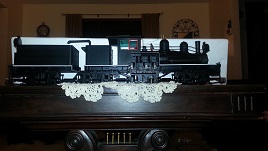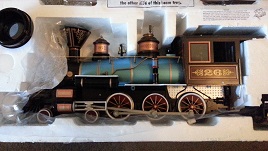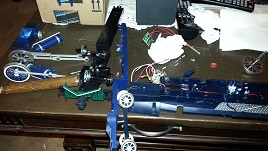Our Transformation Of The Side Yard - A Garden Scale Railroad!
I had been reading about a number of different approaches to garden scale railroading. Most folks agree that you need to raise it off the ground. Some folks want it on the ground, and will go to all the effort to pour concrete "roadbeds" for their track. It seems the main culprit in keeping the track off the ground is frost heave. Considering we don't really get cold enough long enough for the ground to freeze, their is no frost heave here in Florida. No frost line to dig down beneath to secure the foundation of the trackwork to.
I used that reasoning for its first incarnation at our house in Wekiva, where I just laid it on the ground, after removing the sod and grading it level of course. Because I would be ballasting the track to keep it in place, and short of a washout of major proportion, needn't worry about more securely attaching it to the ground. This plan worked well and allowed me to introduce a water feature without needing any major bridgework, just some civil engineering for the embankments, and a water hose to find the "low ground". Once I found the natural runoff path, it was easy to replace the sandy bottom with backer board and colored mortar, a section at a time. It eventually streched from one end of the yard to the other. The ground level route was soon the water level route, complete with a passing siding. I was limited only by my imagination (and the amount of track I had).
It all started from a much smaller oval of track on the patio. This grew into a larger oval of track all around the pool with some sidings onto the patio. When that became too much of a nuisance, I modified it to run along the house from the patio out into the side yard. I put my "wye" switch to good use and constructed a "wye" track just outside the pool screen room to allow a train to turn around and go in any either direction. It took up a good part of the yard, but I was able to drive over it with the lawn tractor, and mow where the track wasn't. The only problem was all the weeds that would grow up through the track and the snad and dirt that got into everything, like the workings of the switches and cars and engines. Everything. Again, you can read about all of this elsewhere, but it is important to the discussion because I learned that track on the ground has its own pitfalls.
Back then, all I had was my radial arm saw, and it didn't like ripping without the proper hold downs. Unfortunately, the hold downs didn't work all that well since I had stripped a couple of the set screws. I got one because my dad had one, so I was familiar with it, and it let me do a lot of woodworking over the years. But now it's just sitting in the garage over at the house in Wekiva, as useless now as it was then for ripping 2x4s into strips to build the splined roadbed stringers out of. So I bought myself a present when I was ready to rebuild the carriage doors, a table saw, knowing there was no way I could do it with the radial arm saw. I learned how to use the table saw while building the new carriage doors, and didn't really need any special equipment or attachments to do so. I did need a miter gauge to do some of the more intricate work of building trestles and bridges. That was the pitfall of raising the track off the ground at the other house, I had no way of ripping the material for building the roadbed.


